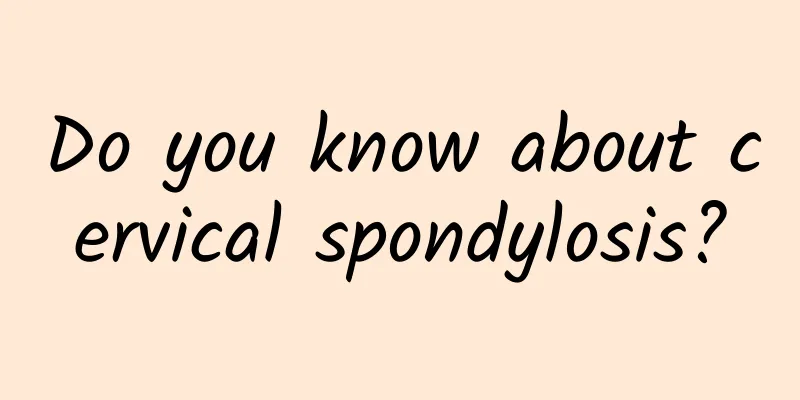Do you know about cervical spondylosis?

|
This is the 3087th article of Da Yi Xiao Hu In people's impression, when people mention cervical spondylosis, they usually have symptoms such as numbness in the hands and pain in the upper limbs. For simple neck pain, most people think it is neck muscle strain, but they are relatively unfamiliar with "cervical spondylosis". What is cervical spondylosis? Cervical spondylosis is a concept proposed by the academic community in recent years. It is also called local cervical spondylosis. It is the mildest type of cervical spondylosis. It generally refers to degenerative lesions of the cervical spine, which can cause pain and discomfort in the neck, nape, and even the shoulder and back (inner side of the scapula). In fact, cervical spondylosis is extremely common in clinical practice and is the earliest type of cervical spondylosis. What causes cervical spondylosis? The incidence of cervical spondylosis has been increasing year by year in recent years, and there is a trend of younger people suffering from it. The incidence is particularly high when the head and neck are kept in a single posture for a long time, especially when working with the head bowed for a long time, indicating that chronic strain of the neck muscles is one of the main causes. It is often caused by fatigue, cold and dampness, improper sleeping posture, and long-term single posture of the head and neck, which causes excessive extension or flexion of the cervical spine. Bad mood can also aggravate the symptoms. How is the manifestation different from other cervical spondylosis? The main symptoms of patients with cervical spondylosis are neck pain and limited neck movement. Most patients have mild initial symptoms and do not take them seriously, and then the symptoms gradually worsen. In addition to neck pain, pain and stiffness in the entire shoulder and back may also occur. Lesions in the upper cervical segment may be accompanied by headaches and neck pain that traction to the back of the head. The patient feels stiff in the neck, and sometimes hears a "cracking" sound when flexing, extending or rotating the neck. Sometimes the head feels "heavy", and the neck cannot support the weight of the head. There is often tenderness in the back of the neck. MRI imaging shows edema of the muscles in the back of the neck. what to do? Cervical spondylosis is the initial stage of cervical spondylosis and the most favorable time for treatment. Most patients can be cured or heal themselves. Cervical spondylosis of the cervical type is mainly treated with non-surgical treatment, and various inducing factors should be avoided. Treatment methods include: cervical immobilization, external fixation of the cervical collar, limiting cervical movement, reducing stimulation and relieving pain. Cervical traction therapy, 1 to 2 times a day, 30 minutes each time, the traction weight can be selected from 1.5 to 2 kg, which can stretch the neck muscles, relieve neck muscle tension, and restore the normal arrangement of the cervical vertebrae. Massage can relieve neck muscle spasms, restore normal muscle sliding and cervical range of motion, but pay attention to the strength. Physical therapy (for example: shock wave, ultrashort wave, high-frequency electrotherapy, etc.) and drug treatment (non-steroidal antipyretic, analgesic, anti-inflammatory drugs or muscle relaxants can be used) may also be given. How to prevent it? The key to the treatment of cervical spondylosis is prevention. Usually, you should actively improve your living habits and work habits, exercise appropriately, strengthen neck exercises, and often do neck exercises and neck exercises. Always pay attention to the condition of your neck and avoid bowing your head for a long time. It is recommended to carry out neck exercises under the guidance of a doctor, step by step, and persist for a long time. You should also maintain good sleeping habits, do not use too high pillows, too soft mattresses, etc. Choose a reasonable sleeping position when sleeping, do not lie prone, you can lie on your back or side. Author: Department of Orthopedics, Tianjin Third Central Hospital Guo ShuzhangChief Physician |
<<: What are the benefits of Tsingtao Beer to the body? How many series does Tsingtao Beer have?
>>: What are green beans? How to store green beans to keep them fresh
Recommend
What to do if a woman leaks urine when coughing
Coughing is a relatively normal condition. It may...
Tumor markers alone cannot provide a definitive diagnosis
□ Zhang Zhiyang and Wang Yingyi As an important p...
Is physical therapy effective for gynecological inflammation?
Physical therapy is naturally better for gynecolo...
Can pregnant women eat cheese slices?
Cheese slices are a kind of cheese product. Chees...
What are the treatments for uterine polyps?
Intrauterine polyps are actually a manifestation ...
When does pregnancy start from the day of menstruation?
Modern women have a better understanding of physi...
The first time I didn't bleed, but the second time I did.
Some female friends did not bleed during the firs...
How long does it take for colostrum to be secreted during pregnancy?
Mothers who have given birth will tell expectant ...
How to effectively treat endometritis?
The female uterus is one of the reproductive orga...
Women have a constant urge to urinate
Many people know that drinking more water is good...
Issues to note when taking physical therapy for cervicitis
Cervicitis is one of the most common gynecologica...
What are the symptoms of thin uterine wall?
Many women know that thin endometrium will affect...
What are the symptoms of uterine fibroids?
Women should pay attention to reproductive health...
How is Bartholin's gland cyst drained?
Bartholin's gland cyst is a gynecological dis...
White floccules in urine of pregnant women
Urination is something we have to do every day, i...









